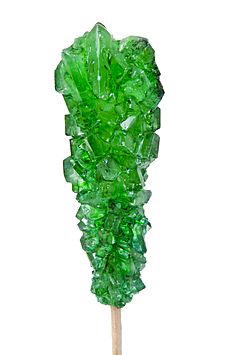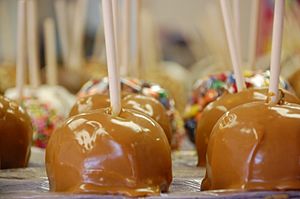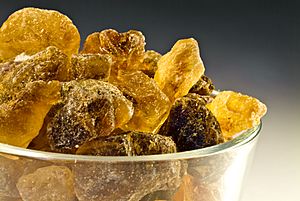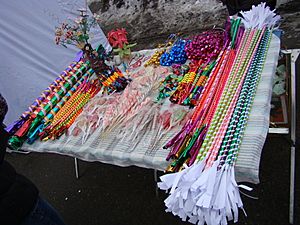Sugar candy facts for kids

Sugar candy is any sweet treat where sugar is the main ingredient. Think of it as a big family of sweets! The most common types of sugar candies are hard candies, soft fondants, chewy caramels, jiggly jellies, and fluffy nougats. In the United Kingdom, people often call this whole group of sweets "sweets." They usually use the word "candy" or "sugar-candy" only for hard candies that are almost pure sugar.
Sugar candy is a type of candy. The candy family also includes chocolates, chewing gum, and other sweet foods. Candy itself is part of an even bigger group called confectionery. This group also includes sweet pastries and sometimes even ice cream.
Contents
How Sugar Candy Started
The very first sugar candies were probably made where sugar cane plants grew naturally. Sugar cane likely came from a place called Papua New Guinea. From there, it traveled to Southeast Asia and other Pacific Islands. Eventually, it reached India and China. From India, sugar then spread to Arab countries and finally to Europe.
Traditional Ways to Enjoy Sugar Candy
People often use sugar candy to sweeten their tea. In Northern Germany, especially in a region called East Frisia, there's a special way to drink tea. They put a large crystal of sugar candy (called Kandiszucker or Kluntje) at the bottom of the cup. Then, they pour hot tea over it, which makes the crystal crack and slowly dissolve.
In Iran, people also enjoy tea with sugar candy, which they call nabat. They either put it in their tea or hold it in their mouth while drinking. In China, sugar candy is used to sweeten Chrysanthemum tea. It's also added to Cantonese dessert soups and a strong drink called baijiu.
Sugar candy is a common ingredient in Chinese cooking. Many homes keep it to marinate meats and add to stir-fry dishes. Some people also believe sugar candy has special health benefits. It's used in traditional foods like yao shan. It's also a popular ingredient in Tamil cuisine, especially in the city of Jaffna in Sri Lanka.
How We Classify Sugar Candies

When we look at sugar candies closely, we can divide them into two main groups based on their structure: crystalline candies and amorphous candies.
- Crystalline candies are not as hard as real mineral crystals. They get their name because their sugar structure is organized in tiny, microscopic crystals. This makes them easy to bite or cut. Examples include Fudge, creams, and fondant. These candies can sometimes feel a bit grainy because of their tiny sugar crystals.
- Amorphous candies have a sugar structure that is not organized into crystals. They usually have more sugar and can be chewy, very hard, or brittle. Hard candies like lollipops, caramels, nut brittles, and toffees are all examples of amorphous sugar candies. Even if some of them are as hard as rocks and look like crystals, their internal structure is not crystalline.
Businesses often group sugar candies into three types based on how much sugar they contain:
- Almost 100% sugar, like hard candies or creams.
- 95% sugar or more, with a small amount (up to 5%) of other ingredients, such as marshmallows or nougats.
- 75% to 95% sugar, with more other ingredients (5% to 25%), like fudge or caramels.
Both crystalline and amorphous candies can be found in each of these three groups.
Different Kinds of Sugar Candy

Hard candies (also called boiled sweets) are a type of amorphous sugar candy. They are usually made from a mix of sucrose and glucose syrups. They are typically 98% or more solid sugar. Hard candies look clear and glassy. Pulled candy, like rock or starlight mints, is a hard candy that has been stretched. This stretching adds air bubbles, making the candy look opaque instead of clear.
Sugar Candy for Medicine
Long ago, candy was not just food. It was also used as a way to take medicine. The sweet taste of candy helped hide the unpleasant taste of the drug ingredients. Today, cough drops and some other medicines still use this idea. They come as sugar tablets with medicine inside, or as pills covered in a sweet sugar coating.
During the Middle Ages, a famous thinker named Thomas Aquinas said it was okay to eat sugar candy during the fasting period of Lent. He thought that "sugared spices" (like comfits) were more like medicine that helped digestion, rather than just food.
Storing Sugar Candy
How long candy stays fresh depends on how much water is in it and how it's stored. Candies with a lot of sugar, like hard candies, can last for many years if they are kept covered in a dry place. When candies with low moisture go bad, they usually lose their shape, color, texture, and flavor. They don't usually grow harmful germs. Good packaging can help keep them fresh longer.
Candies spoil faster if different parts of the candy have different amounts of water (for example, a candy with both marshmallow and nougat). They also spoil faster if stored in a humid place. This happens because water can move from a moist environment into a dry candy, making it soft and rubbery. Or, water can leave a moist candy in a dry environment, making the candy hard and brittle.
Sugar Candy in Stories
In George Orwell's book Animal Farm, there's a raven named Moses. He tells the other animals about a wonderful place beyond the clouds called "Sugarcandy Mountain." He says it's a happy country where animals will finally rest from their hard work. This story is a way for Orwell to talk about religion and how it can be used to give people hope for a better life after death, sometimes to keep them from questioning those in power.




